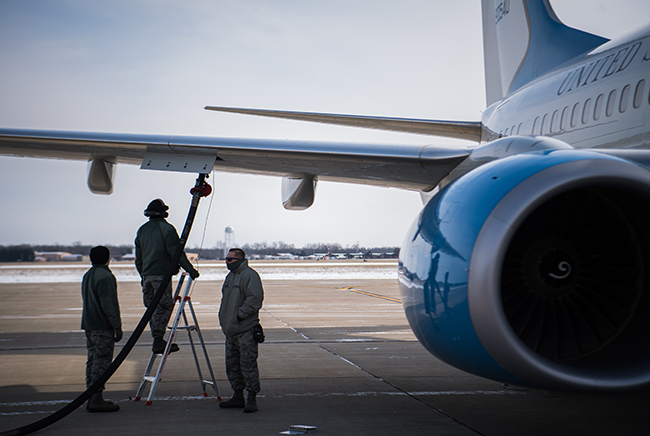
A1C Anthony Uelk, on the ladder, along with fellow 932nd Airlift Wing flight line crew chiefs, brave the polar vortex record low temperatures while refueling a C-40 in preparation for a launch on Jan. 31, 2019, at Scott AFB, Ill. Air Force photo by Christopher Parr.
The Air Force’s push to quickly develop small batches of aircraft with short life spans could exacerbate the service’s current problem with rising operations and maintenance costs, an expert at a leading think tank argues.
Todd Harrison, director of defense budget analysis and the Aerospace Security Project at the Center for Strategic and International Studies, argues in an Oct. 29 report that the current state of the Air Force is “much like a power-on stall in an airplane.”
“Despite the Air Force’s budget being at full throttle and near-record levels, it has fewer aircraft and personnel, accomplishes fewer flying hours in total each year, has a declining mission-capable rate, and has a higher mishap rate,” he wrote. “Small fleets of aircraft are expensive to operate and maintain. Combining small fleets of specialized platforms into larger fleets of multimission platforms when possible could potentially reduce overall operating costs.”
The Air Force is simultaneously pursuing technologies that make it possible to quickly swap different capabilities between aircraft (like open architectures and the AgilePod), designing ways to split a specific mission between multiple platforms (like the Advanced Battle Management System), and improving its rapid software development instead of launching procurement programs for single-mission fleets.
As part of Air Force acquisition boss Will Roper’s push to get away from traditional procurement—in which the service waits for a product to be fully developed with all of its features before fielding—he is taking that idea to the aircraft realm. The “Digital Century Series” would come up with numerous new designs that each meet some USAF needs, instead of giving the Air Force large fleets of multimission aircraft.
Harrison, who compared congressionally mandated force-structure reports from the Air Force, MITRE Corp., and the Center for Strategic and Budgetary Assessments, noted that only MITRE raised the issue of how small fleets could hinder the service in the long run. The Air Force owns more than 30 types of aircraft that have fewer than 50 airframes per fleet, 16 of which are comprised of six or fewer planes.
“This finding in the MITRE report on operation and sustainment costs appears to be in conflict with the Air Force’s acquisition strategy for the Next-Generation Air Dominance program, which calls for developing small batches of multiple types of aircraft in rapid succession,” Harrison wrote. “The ‘Digital Century Series’ approach for the next-generation fighter could leave the Air Force with more costly small fleets of aircraft that exacerbate growth in O&S costs and force difficult tradeoffs between capability and capacity.”
Total ownership costs drop as fleets get larger. Harrison found that five fleets of 72 aircraft (or 360 total), as could be designed under the Digital Century Series, would cost about $6.8 billion a year to operate and sustain—the same as a 1,800-piece fleet. In comparison, buying 360 of the same airframe would cost $3 billion annually in operations and maintenance.
“While small fleets may be desirable for rapid integration of new technologies into the force and maintaining competition in the industrial base, this approach would likely lead to higher operation and sustainment costs and a smaller force than the Air Force could otherwise afford,” he said.
Doing away with certain specialized fleets, like the Air Force’s cadre of business jets that ferry senior leaders around the world or niche intelligence-gathering planes, would drive down costs like those of training people to fly and maintain many unique platforms, Harrison said.
The data that backs up that assessment could give the Air Force “better justification for retiring some of the legacy fleets” when talking to Capitol Hill, Harrison told reporters.
Other factors are in play: The Air Force is piloting new data-driven sustainment approaches that aim to push down maintenance costs, and introducing new software and processes that streamline certain aspects of missions like planning—dropping those costs in turn as well. But those experimental programs acknowledge that the best candidates are large fleets because they turn out the most data and have the broadest application.
In contrasting the three studies, Harrison also noted that the force-structure reports did not publicly consider how intercontinental ballistic missiles or space assets could shape future aircraft needs, such as passing off certain surveillance capabilities to satellites instead of using planes.
The study authors also missed the opportunity to rethink whether the Air Force should keep some of its current roles and missions, whether it should pass them off to other services, and whether each service should own similar aircraft fleets, among others. Harrison suggested creating a new roadmap for the future of remotely piloted aircraft, a deep-dive on contracting out more missions, a personnel system review, and more.
“What is needed is a rebalancing plan throughout the 2020s that adjusts dynamically as the resources available change, new threats emerge, and new capabilities come online,” he wrote. “A smaller rebalanced force that focuses more on long-range, long-loiter, and increasingly autonomous and remotely operated capabilities may be more desirable than the current program of record. Such a rebalancing, however, will require difficult tradeoffs.”